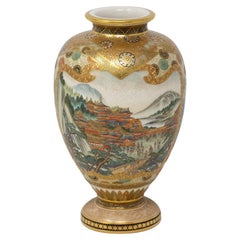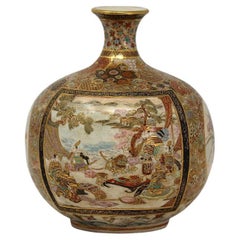Hozan Furniture
2
to
2
2
2
2
1
1
1
1
1
1
1
1
1
2
2
2
1
5,150
4,013
2,454
2,236
Creator: Hozan
Nô Theatre Dancers, 19th Century Meiji Period Japanese Okimono Sculpture
By Hozan
Located in PARIS, FR
Two superb Nô theatre dancers in carved wood and bone by the artist Hōzan 芳山, Japan late 19th century.
Decorations of a fox on the head of one dancer and carved dragons, chrysanthe...
Category
19th Century Japanese Meiji Antique Hozan Furniture
Materials
Bone, Wood
Antique Japanese Meiji Period Satsuma Vase Hozan
By Hozan
Located in Newark, England
Meiji Period (1868-1912)
From our Japanese collection, we are pleased to offer this Antique Japanese Meiji Period Satsuma Vase by Hozan. The vase of tapered ovoid form with a pinch...
Category
Early 1900s Japanese Meiji Antique Hozan Furniture
Materials
Enamel
Related Items
19th Century Pair of Japanese Bronze Lions Bookends, Meiji Period
Located in Buenos Aires, Olivos
This superb and rare pair of Japanese Meiji period bronze bookends are cast in solid bronze and depict a pair of Lions, with their heads raised. These finely sculpted pieces are beau...
Category
Late 19th Century Japanese Meiji Antique Hozan Furniture
Materials
Bronze
Japanese Meiji Period Carved Wood Okimono Man with Rabbits
Located in Newark, England
The charming figure, carved from a single piece of wood is exceptionally carved showing the male figure with humorous expression holding two Rabbits one by the ears and the second under his arm. A third Rabbit stands at the feet of the male looking up, each rabbit with a different expression. The male figure is wearing traditional Japanese attire with his hair tied back stood upon a naturalistic base. The figure dates to the Meiji Period (1868-1912) circa 1900.
Notes The Rabbit is one of the 12 animals to feature in the Japanese Zodiac signs which follows the Chinese astrological system along with the Rat, Ox, Tiger, Rabbit, Dragon, Snake, Horse, Goat, Monkey, Rooster, Dog, Pig. Such division is connected with the Jupiter cycle around the Sun, which lasts about 12 years. As 2023 is the year of the Rabbit...
Category
Early 1900s Japanese Meiji Antique Hozan Furniture
Materials
Wood
Japanese Bronze Meiji Period Bronze Sculpture of a Usagi (Rabbit)
Located in West Palm Beach, FL
Japanese Bronze Meiji Period Bronze Sculpture of a Usagi (Rabbit)
Japan, Circa 1900
Immerse yourself to the elegance of Meiji-era Japan with this stunning bronze sculpture depictin...
Category
Early 20th Century Japanese Meiji Hozan Furniture
Materials
Bronze
Small Japanese Articulate Crab Jizai Okimono Meiji Period Signed
By Myochin Hiroyoshi
Located in Atlanta, GA
A small copper crab with articulated legs made by Myochin Hiroyoshi in the late Meiji Period circa 1890-1900s. As an ornamental display item, this type of small sculpture with moving...
Category
Early 20th Century Japanese Japonisme Hozan Furniture
Materials
Copper
Japanese Bronze Torii Gate Sculpture Meiji Period
Located in Newark, England
Beautifully sculpted Japanese Meiji period Torii gate sculpture. The sculpture made from solid bronze with a beautiful patination throughout dating to the Meiji period 1868-1912 circa 1890. The gate of traditional form representing the Matsuo Shrine in Kyoto. The characters read ???? translated directly to Matsuo Shrine.
Notes The Torii gate sculpture was crafted after the famous Torii gate which is found in the Arashiyama district in Kyoto. It houses Matsuno’o Taisha (Matsunoo Taisha ????) one of the oldest shinto shrines in Kyoto dating to 701, approximately 100 years before the city of Kyoto. It boarders the mountains and has a distinct main hall dating to 1397 which is also one of the oldest buildings in the city of Tokyo. The shrine’s spring is famous for its restorative properties and sake and miso producer’s patron the shrine with their particular industries relying on the pure water to survive. The distinct giant Torri gate stands at 14 meters tall alluding to its significance in the city. Three beautiful gardens can...
Category
Late 19th Century Japanese Meiji Antique Hozan Furniture
Materials
Bronze
19th Century Okimono Bronze Japanese Crab Sculpture Paperweight
Located in Los Angeles, CA
A 19th Century Okimono Bronze Meiji period Japanese Crab.
The crab is of good weight and could be a decorative object or a paperweight. The sculpture is very detailed, down to the...
Category
19th Century Japanese Meiji Antique Hozan Furniture
Materials
Bronze
Satsuma earthenware vase by kinkozan, Meiji period
By Kinkozan
Located in Tel Aviv - Jaffa, IL
the body of this small marvelous vase is painted with a scene of a puppet show vendor with his wood backpack, on top of the backpack there are toys and dolls, he is surrounded with a group of 6 children, and on the background you can see a village.
on the other side of the vase there is an amazing painting of flowers and on the sides there are two amazing strong pine trees, the amorphous background is decorated in a "Tortoiseshell" color and design that gives it a real character and which is quite rare to see on satsuma pottery.
all the vase is over richly overpainted over the glaze with gold, which gives it its depth and realism.
signed Kyoto Kinkozan zo, and sealed Kinkozan zo
Kyoto’s Satsuma:
The painting technique used in Kyoto’s Satsuma-style ware is said to be the invention of the sixth generation Kinkōzan Sōbei (1824–1884). The Kinkōzan were a famous family of Kyoto Awataguchi potters who made ceramics that were used at Shōren'in, a temple closely tied to the imperial family, and by the shoguns of the Edo government. In fact the shogun is said to have granted them the name Kinkōzan. With the upheavals at the end of the Edo period, however, and the reforms of the subsequent Meiji government, the potters lost their traditional patrons and had to develop new markets.
Just at that time, the visit of a certain Westerner is said to have decided them to embark on overseas trade. By 1870, they had perfected Kyō Satsuma...
Category
1890s Japanese Meiji Antique Hozan Furniture
Materials
Gold
19th Century Japanese Cloisonné Small Vase, Meiji Period
Located in Lincoln, Lincolnshire
This is a very decorative small cloisonné vase, made in Japan and dating to the 19th Century, Meiji period. The vase has a good baluster shape w...
Category
19th Century Japanese Meiji Antique Hozan Furniture
Materials
Ceramic
Antique Japanese Meiji Satsuma Painted Vase
By Satsuma
Located in LA CIOTAT, FR
A petite and beautiful hand-decorated ceramic baluster vase, painted all around with traditional Japanese motifs, including native flora, birds and bamboo stems on a creamy glazed background. The colour palette is bold and bright, with highlights of green, red and blue, together with plentiful gilt relief...
Category
19th Century Japanese Meiji Antique Hozan Furniture
Materials
Ceramic
Japanese Cloisonne Box, Meiji Period, Late 19th Century, Japan
Located in Austin, TX
A very fine and intricately decorated Japanese cloisonné box and cover, Meiji period, late 19th century, Japan.
The lidded trinket or jewelry...
Category
1890s Japanese Meiji Antique Hozan Furniture
Materials
Brass, Copper, Enamel
Large 19th Century Japanese Meiji Period Bronze Vase
Located in San Francisco, CA
A large and elegant Meiji period bronze vase with floral decoration and original patina, unsigned.
Japan, last quarter of the 19th century.
Category
Late 19th Century Japanese Meiji Antique Hozan Furniture
Materials
Bronze
Japanese Meiji Satsuma Polygonal Vase
By Kyoto Pottery
Located in Gainesville, FL
Japanese Meiji Satsuma polygonal vase with four panels. Each panel shows a different scene. Fine gilding and hand enameling. Marked on the bottom with shimadzu mon.
Category
Late 19th Century Asian Meiji Antique Hozan Furniture
Materials
Pottery
Previously Available Items
Antique Japanese Meiji Period Satsuma Vase Hozan
By Hozan
Located in Newark, England
Meiji Period (1868-1912)
From our Japanese collection, we are pleased to offer this Antique Japanese Meiji Period Satsuma Vase by Hozan. The vase of tapered ovoid form with a pinch...
Category
Early 1900s Japanese Meiji Antique Hozan Furniture
Materials
Enamel
Japanese Satsuma Vase Hozan
By Hozan
Located in Newark, England
Japanese satsuma earthenware vase Meiji Period. The vase of globular shape with a tight pinched neck and flared rim opening decorated with geometric patterns with scrolling gilt boar...
Category
Late 19th Century Japanese Meiji Antique Hozan Furniture
Materials
Earthenware, Ceramic
Hozan furniture for sale on 1stDibs.
Hozan furniture are available for sale on 1stDibs.




